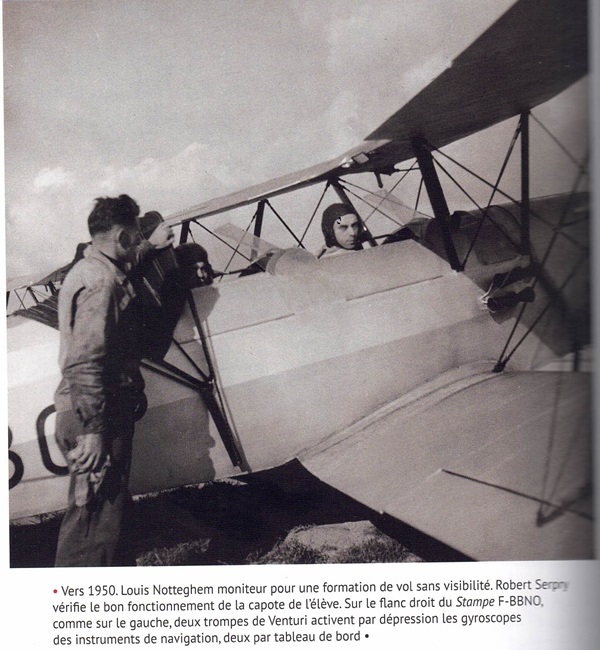in those two cases, SEP vs MEP only changes the probability of a bad outcome
Correct phrasing would be: In those two cases (low visibility takeoff and takeoff towards rough terrain) SEP vs MEP presents significant difference in the probability of bad outcome.
A compass would have been normal, needle and ball, some did some just used a piece of wool, ASI usually, not usually an AI.
Yes wide grass helped but not at zero zero or anywhere near it. Most grass strips had bollards (balise) which you looked at out of the side front 3/4, but you had to see the bollards, preferably at least 2 of them and they are 60m apart.
At least that is the experience of the group at Niort LFBN and still fly one (Stampe) regularly now, along with their Morane Saulnier and other such old timers.
A wide grass runway made takeoffs easier. The book specifically says the Stampe and MS.315 trainers had no artificial horizon, just turn (needle and ball) and airspeed indicators; no mention of compass, but it must have been the spirit type. The aircraft were used only for local flights, including recovery from stalls and spins; navigation was practised on the ground with a Link Trainer.
Emir wrote:
I don’t see how this can be true.
Better phrasing: in those two cases, SEP vs MEP only changes the probability of a bad outcome (but the comparison can be made in both cases).
Interesting thing about the Stampe for a VSV/ LVTO/zero zero. I would take it that they would have only had a compass to direct them during the take off roll as I don’t recall a Stampe with a DI.
The problem with a compass IIRC is a tendency to swing to the North during acceleration. So if you followed the compass to guide you on the runway, during a LVTO you are going to drive in a nice curve off the runway.
Yes, probability of ditching IF you’re flying over water ~= probability of crashing IF taking off zero-zero (again, very rough estimation)
Now I get it 
But even with a “good” twin (maintaining level flight OEI), it’s still possible to lose both engines, or get severe icing which prevents level flight. The probability is lower (which is why many accept flying twins above water but not singles), but it still exists
I agree.
SEP/MEP merely changes the probability of a bad outcome in those two cases.
I don’t see how this can be true.
Yes, probability of ditching IF you’re flying over water ~= probability of crashing IF taking off zero-zero (again, very rough estimation)
I agree a MEP which loses climb / level ability just by having OEI is not great. The whole idea of a twin is to reduce the probability of going down by having a second engine ^^
But even with a “good” twin (maintaining level flight OEI), it’s still possible to lose both engines, or get severe icing which prevents level flight. The probability is lower (which is why many accept flying twins above water but not singles), but it still exists, and I was merely using that as a comparison point for zero-zero takeoff.
To put it another way: whatever your aircraft is, taking off zero-zero (assuming it’s not just a local patch of fog) is comparable to:
SEP/MEP merely changes the probability of a bad outcome in those two cases.
In a MEP, the main risk I’m considering (there are obviously others) is the risk of losing climb / level flight at low altitude.
I understand that for non-commercial MEP flying there’s no mandatory requirement for climb on one engine but for me flying such MEP is pointless. In other words, for me there’s no possibility that MEP looses ability to climb or loses ability to level fly at low level OEI.
Losing the ability to fly level is similar in probability to ditching in the North Sea for instance. Compared to ditching, you’re less likely to run out of fuel (maybe…), but put more stress on the engines (takeoff power). I admit this reasoning is a bit shaky, but the ballpark comparison is about correct.
I’m sorry but I still don’t get your point. Losing the ability to fly level can never be similar to probability of ditching. Probability of ditching is firstly related to flying over water – if you don’t fly over water, the probability of ditching is zero. Losing the ability of level flying OEI in MEP is related to type of MEP, mass, weather and probability of losing the other engine after losing the first one.
derek wrote:
It literally was a hood that covered the entire rear cockpit.
Similar pram-style setup on an SV.4, also with venturis:

Once, there was a fog bank perpendicular across the runway. I remember wondering whether it was safer to take off at the sunny end and climb a few hundred feet through it, or start at the foggy end and fly straight out. I opted for the former based on previous exposure: a little enroute IMC, but only one takeoff on foggles.
An anecdote from a friend, where the fog was only 10’ high: holding at the end of the runway debating whether or not to depart, a looming shadow slowly coalesced into the form of a grass-cutting tractor. 
If it’s just local thin fog (stuck to the ground), it’s very possible to have a quite good view of the ground once airborne. So it’s less dangerous because you can still aim for a field if your engine fails.
As for 100/200/500 cloud base, I’m not IR but I think it would depend on whether the terrain is familiar, if it’s predominantly fields or forest around, and maybe avionics too (synthetic vision can MAYBE help, again I have no experience in that). In a SEP, very low cloud bases are always a very serious question, including en-route.